Fujifilm XF1 Review
Fujifilm XF1 Introduction
The Fuji XF1 is a premium digital camera in a compact body which houses the world's smallest mechnical zoom paired with Fuji's unique 12 megapixels EXR-CMOS sensor. Packed with features including full manual controls, manual focus and custom white-balance, the XF1 makes these more accessible than any compact camera with dual control-dials and an traditional exposure mode-dial.
The ultra-wide-angle 4X optical zoom lens has an ultra-bright F/1.8 maximum aperture which dims to F/4.9 at the telephoto end yet manages to slide almost entirely into the camera body when powered off.
The 12 megapixels sensor of the Fuji XF1 has a standard ISO range of 100 to 3200 at full-resolution. The tri-mode EXR technology exclusive to Fuji let it capture low-noise images or up 4 stops extra dynamic-range at 6 MP by cleverly combining pixels. Given this one is built using BSI-CMOS technology, it can capture full 1080p HD video and shoot continuous at speeds up to 7 FPS.
This camera review covers the usability and performance of the Fuji XF1.
Fuji XF1 Features
Sensor
- Fuji EXR CMOS sensor
- High-Resolution, Low-Noise, Dynamic-Range priority modes
- JPEG, RAW or JPEG+RAW Output
- 1920x1080 @ 30 FPS 16:9 HD Video
- 640x480 @ 70 FPS 4:3 SD Video
- 320x240 @ 120 FPS High-Speed Video
- 320x112 @ 200 FPS High-Speed Video
High-Resolution Priority Mode (EXR-HR)
- 12 Megapixels maximum resolution
- ISO 100-3200 standard sensitivity range
- ISO 6400 @ 6 MP with 100% dynamic range
- ISO 12800 @ 3 MP with 100% dynamic range
- Automatic and manual dynamic range, 100-400%
- Automatic ISO up to 400-3200
- Manual ISO up to 12800
Dynamic-Range Priority Mode (EXR-HR)
- 6 Megapixels maximum resolution
- Automatic ISO up to 3200
- Automatic dynamic range up to 1600%
- Manual dynamic range up to 1600%
- Automatic Exposure Only
- Flash Disabled
Low-Noise Priority Mode (EXR-HR)
- 6 Megapixels maximum resolution
- ISO 100-3200 sensitivity range
- Fixed 100% Dynamic Range
- Automatic or manual ISO up to 3200
Lens
- Fujinon 25 - 100mm equivalent lens
- Bright F/1.8 - 4.9 maximum aperture
- F/1.8 - 11 Aperture range, 1/3 EV stops
- Optical Image Stabilization
- Mechnical Zoom, slides into camera
- 3cm Minimum focus distance at 25mm
- 50cm Minimum focus distance at 100mm
Exposure
- PASM Exposure modes
- 1/2000s - 30s Shutter-speed
- Exposure-Compensation, ±2 EV, 1/3 EV steps
- Flash-Compensation, -2/3...+2/3, 1/3 EV steps
- Multi-Segment, Spot & Average metering
- AEB, 3 Frames, ±1 EV, 1/3 steps
- ISO Bracketing, ±1 EV, 1/3 steps
- Film Simulation Bracketing
- Dynamic Range Bracketing
- Fixed 1/3 EV exposure steps
Focus & Drive
- 49-Area Contrast-Detect autofocus, 5 Sizes
- Auto or Single or Tracking focus-point selection
- Single-Shot, Continuous or Manual Focus
- 7 FPS Drive, Max 16 JPEG or 8 RAW
- 10 FPS Drive at 6 MP, Max 200 JPEG
- Motion Panorama, 360°, 180° & 120°
- 2s & 10s Self-Timers
- Optional AF-Assist lamp
Images Parameters
- Automatic, Preset, Kelvin and Custom WB
- WB fine-tuning, 19-steps along 2-axis
- Film Simulation: Provia, Velvia, Astia, B&W
- Adjustable color-saturation, 5 steps
- Adjustable sharpness, 5 steps
- Adjustable highlight-tone, 5 steps
- Adjustable shadow-tone, 5 steps
- Adjustable noise-reduction, 5 steps
Viewfinder & Displays
- 3" LCD, 460K Pixels, 100% coverage
- Digital-Level, Tilt axis only
Body & Construction
- Dual Control-Dials
- Customizable Function button
- Customizable E-Fn button
- Metal tripod mount
- Built-in flash, 7.4m (W) - 2.7m (T) reach
- Analog NTSC/PAL output
- 1080i HDMI output
- USB 2.0 connectivity
- SDXC memory-card slot
- Proprietary Lithium-Ion battery
Fujifilm XF1 Usability - How easy is it to use?
The Fuji XF1 has a simple rectangular design. Its sliding lens barrel protrudes slightly when powered off and extends out up to 5cm. The body of the camera feels solid but the lens barrel seems a little light and plasticky.
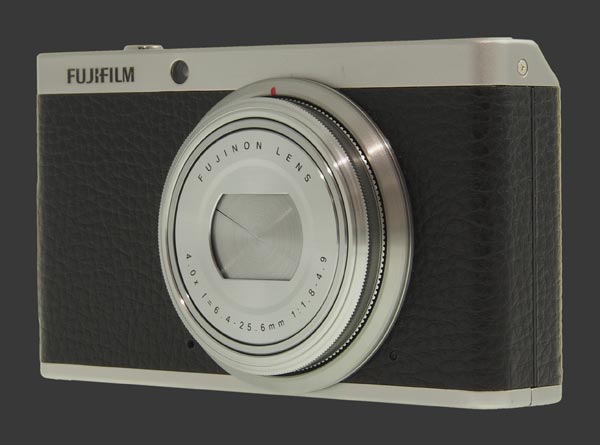
Given its mechanical zoom, holding the XF1 naturally requires two hands which compensates for the lack of any kind of grip. The textured surface has a good non-slip coating but using a wrist-strap is highly recommended to avoid dropping the camera. Fuji includes a simple cloth wrist-strap with the XF1.
This digital camera is powered into Capture mode by an unusual three-step process which quickly becomes second nature. First, the lens barrel is unlocked with a slight twist. This lets it be pulled out about 1.5cm. Once out, twisting the lens barrel to the 25mm marking turns the camera on. The mechanical zoom continuous to extend the lens further. Hover the pointer over each step below to see the motion:
- Unlock
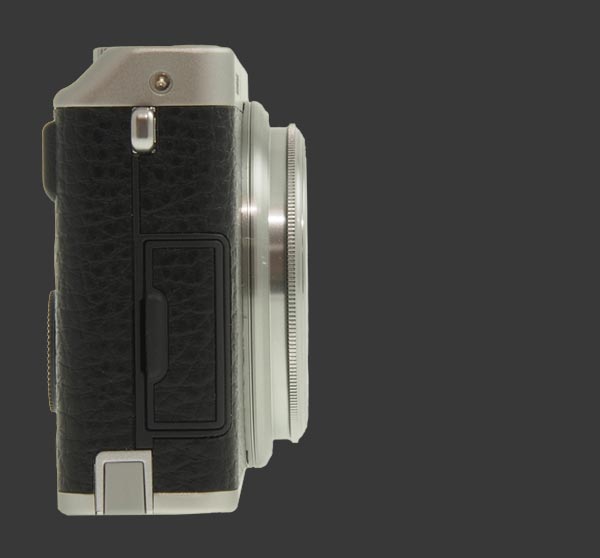
- Pull
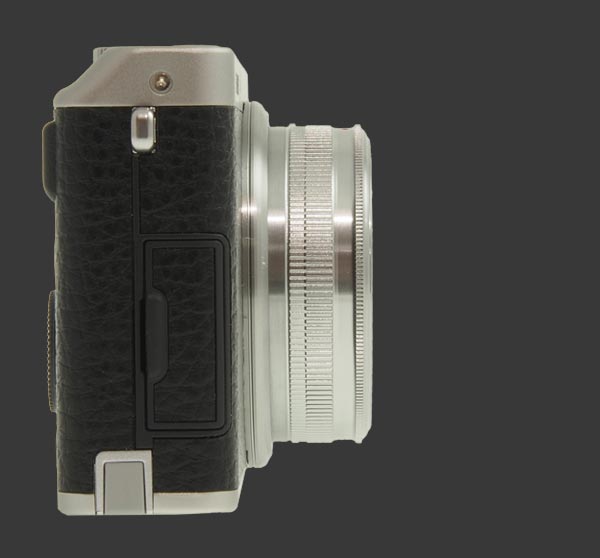
- Twist On
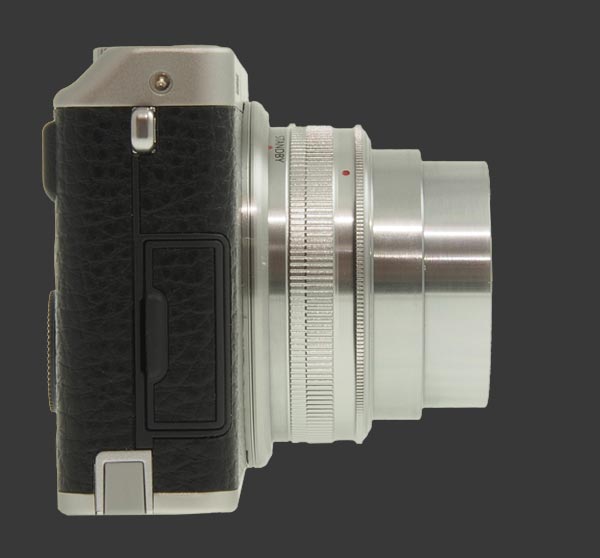
- Zoom In
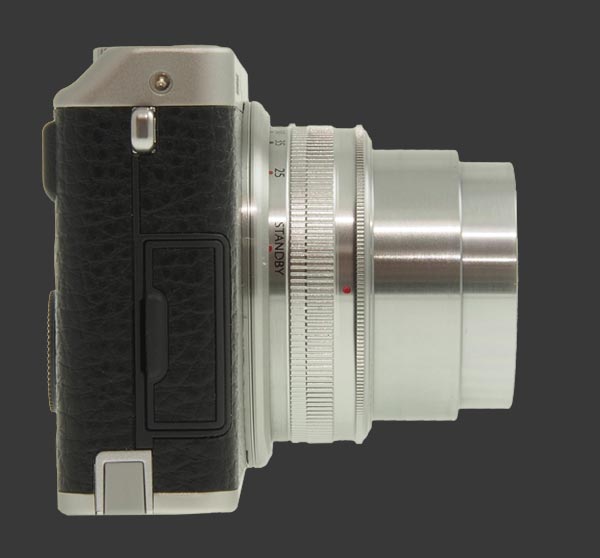
- Max Zoom
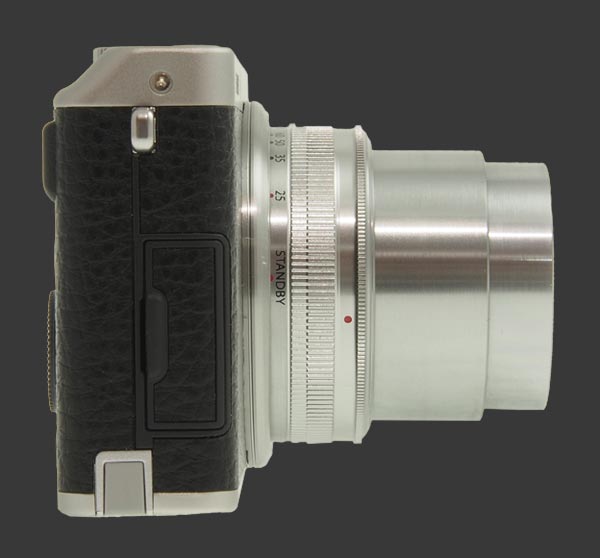
This is a truly clever design. Most importantly, it allows to fit a mechanical zoom in a camera which measures a slim 33mm when off. This makes the Fuji XF1 the only pocketable mechanical zoom camera. Such zooms are a pleasure to use and very advantageous: They are infinitely precise, extremely quick and quiet. Only Fuji currently builds cameras like this.
The camera can also be powered into Playback mode with the lens locked by holding down the Play button for 2 seconds. Pressing it again from there turns the camera off. When the lens is open, the Play button switches between Capture and Playback mode just as usual.
There is not much else to see on the front except for the optional AF-Assist lamp and two holes on either side of the lens barrel for the stereo microphone. The right side of the came has a small rubber flap covering the ports while there is nothing to see on the left side.
The top plate is rather sparse with only three controls grouped to one side. Right most is a traditional mode dial which has 10 positions with strong detents. The traditional PASM modes are all there and work with the sensor in EXR-HR mode which defaults to 12 megapixels output. Resolution can be reduced to 6 or 3 megapixels, in which case the Fuji XF1 may switch to EXR-SN mode under certain conditions. There are also 2 custom modes which can be set to any EXR or PASM mode.
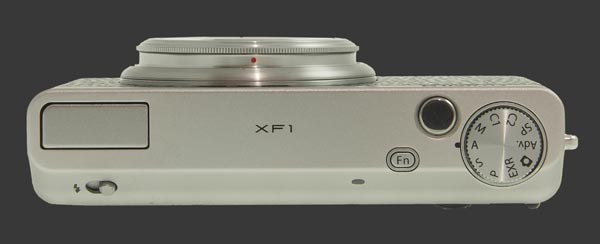
The EXR position on the mode-dial regroups all EXR modes under one. A menu options then selects between Auto-EXR, EXR-HR, EXR-SN and EXR-DR. It is really too bad they are bunched up together like this because it takes longer to set the desired one. There is a highly complex set of interaction between each mode and other camera settings such as ISO and Dynamic-Range, so the camera informs when it has to change a settings. It also goes a great job at restoring the original setting when undoing mode changes.
There is a completely Automatic mode, labeled by a camera drawing, which disables most settings. Still, Film Simulation and the maximum automatically selected ISO can be set between 400 and 3200. The Adv position groups together Advanced modes:
- Advanced Filter: Chose among 11 effects which could all be done later by computer instead without irreversibly affecting your images.
- Motion Panorama 360: Sweep the scene in any horizontal or vertical direction to create a panorama spanning 120°, 180° or 360°. A cylindrical 360° option tries to make the ends blend seamlessly.
- Pro Focus: Blends two exposures to simulate shallow depth-of-field.
- Pro Low-Light: Blends four exposures to reduce image noise.
- Multiple Exposure: Overlays two exposures.
- Individual Shutter 3D: Combines to exposures into a 3D image.
The SP position groups all Scene modes for those intimidated by manual controls. There are 16 to choose from including Fuji classics like Natural Light+Flash mode that takes two shots, with and without flash. There are two Night modes which usefully distinguish between hand-held and tripod use.
Notably lacking from the mode-dial is a video-mode. Shame on Fuji, the X10 has one! Instead there is a Video-Record button on the rear which starts filming two seconds later and stops one second after being pressed. At least, optional HD guidelines can help frame video but to see them one has to chose the right guides, enable them in the custom view and switch to the custom view as well.
Next to the mode-dial is a small two-stage shutter-release. It has a short travel to the halfway point and triggers immediately below. While it is inwards from the side of the camera, the shutter-release is easy to reach. Near it is the customizable Fn button. There are 12 options to choose from but, since the XF1 does not provide a direct button for changing ISO, this will be its most likely function.
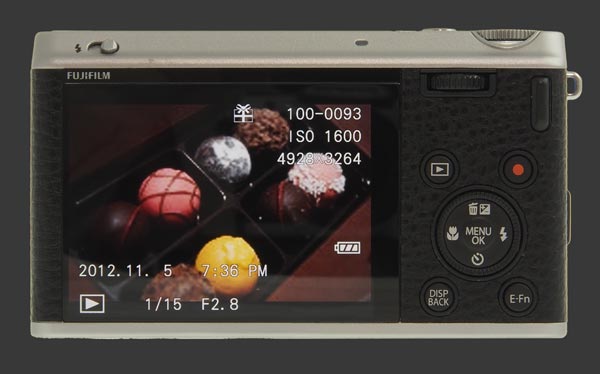
The back of the camera has a 3" LCD with 460K pixels. The view is sharp and motion is fluid. Visibility is good but the screen aggressively dims down to save power. Just tap the shutter-release to brighten the LCD again. The biggest complaint about this camera is the poor accuracy of the display. The LCD is not Exposure-Priority and the optional Live-Histogram is based on the display brightness, making it useless most of the time.
Optical distortion is high although it does not always appear! The XF1 actually corrects for distortion by internal processing and previews the corrected image. The instant review does not. This is why the image shown after taking a picture is slightly wider and more distorted. What is shown makes into RAW files. Unfortunately, RAW shooters cannot preview the correct framing even if the camera is set to capture RAW only. For JPEG shooters, the framing preview is close but not perfect.
The back of the camera includes 2 controls dials, a 4-way controller and 4 extra buttons. The upper control-dial is found right next to the thumb. It has soft detents and is actually clickable. Normally the upper control dial sets the main exposure parameter, such as the aperture in Aperture-Priority mode. In Manual mode though, clicking the upper control-dial toggles the parameter being changed. The other parameter is then set by the lower dial, except for MF. In that case, the lower control-dial sets the focus distance.
The lower control-dial is located around the 4-way controller. It is rather slim with soft detents. About of the 4-way controller, each direction is assigned a function:
- UP: Lets direction buttons control EC and exposure parameters. This modal interface is unfortunately error-prone, potentially causing accidental changes if not being very careful.
- RIGHT: Selects the flash mode between Auto, On and Slow-Sync. These only apply with the flash raised, otherwise it simply stays off.
- DOWN: Sets the self-timer between Off, 2s and 10s. Timers thankfully do not reset after each use.
- LEFT: Toggles Macro focusing on and off.
Below the 4-way controller are the DISP and E-Fn buttons. DISP cycles through various display modes, one of which can be customized to include the single-axis digital level. E-Fn acts like a Shift function for the cardinal points of the 4-way controller and both buttons above it. When pressed, the LCD shows what each of those do in their shifted state. There are a whopping 14 options to choose from for each button. This excellent interface puts a large number of functions two button presses away.
The bottom of the XF1 has a poorly-placed metal tripod mount. With a small tripod head, it may be possible to change memory and batteries without removing the camera.
Without a doubt, the Fuji XF1 has an excellent interface and is more pleasant to use than most other compact cameras. Ergonomics may not be perfect but the mechanical zoom is enough to excuse everything else. The tiny Fn button is flush with the top-plate, making it difficult to use and impossible to do so with gloves on. The most serious usability issue is the poor accuracy of the display which can be corrected via a firmware update. For now, this forces the photographer to review his images more often than desirable.
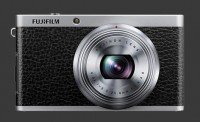 |
Please Support Neocamera
All information on Neocamera is provided free of charge yet running this website is a huge endeavor. Purchases made via affiliate links found throughout the site help keep it running and up-to-date. There is no additional cost to you, so please consider buying via these links to our affilates:
Thank you for your support!
Fujifilm XF1 Highlights

Sensor-Size: 9 x 7mm

Actual size when viewed at 100 DPI
| 12 Megapixels Fixed Lens | ISO 100-3200 |
| 4X Mechanically Linked Ultra-Wide Optical Zoom | Shutter 1/2000-30s |
| Built-in Stabilization | Full manual controls, including Manual Focus |
| 7 FPS Drive, 8 Images | Custom white-balance |
| 1920x1080 @ 30 FPS Video Recording | Spot-Metering |
| 3" LCD 460K Pixels | Lithium-Ion Battery |
| Secure Digital Extended Capacity |
Updates
2025.11.13

Best Gifts for Photographers in 2025 by Budget
The annual Neocamera Photography Gift Guide updated to 2025. Find great gifts for photographers with any price budget.
2025.07.07

Stellar Photo Recovery Review
Review of Stellar Photo Recovery V12. This Windows and MacOS software can recover photos and videos in a huge number of formats from memory cards, USB drives, SSDs and HHDs.
2025.05.14

Huion Kamvas 13 Gen 3 Review
In-Depth review of the Huion Kamvas 13 Gen 3 Pen Display Tablet for photographers and graphic artists.
2025.01.18

Fujifilm GFX 2025 Lens Roundup
Lens Review roundup of Fujifilm GFX Medium-Format lenses. Quality, performance and handling of the GF20-35mm F/4R WR, GF30mm F/3.5 Tilt-Shift and the GF55mm F/1.7.
2024.11.18

Best 2024 Photography Gifts for Every Budget
Great gifts for photographers and photo enthusiasts selected for every budget among the best products of 2024.
2024.08.07

Eye Protection Tips for Professional Photographers
The four main considerations for professional photographers regarding eyewear.
2024.07.14

Fujifilm X100VI Review
Flagship fixed-lens compact digital camera with a 40 MP sensor and Image-Stabilization, a first for the series. Retro design featuring dual control-dials, plus direct ISO, Shutter-Speed and EC dials. Its hybrid viewfinder can switch between EVF and OVF mode.
2024.05.09

Fujifilm GFX100 II Review
Flagship 102 Megapixels Medium-Format Mirrorless Digital Camera with 8-Stop 5-Axis IBIS, 8 FPS Drive, 8K Video and 400 MP Super-Resolution capture in a weatherproof and freezeproof body with dual control-dials and dual memory-card slots.
2024.04.03

Fujifilm X-T5 Review
Newest Fujifilm flagship boasting a 40 MP APS-C sensor, 5-axis IBIS with 7-stop efficiency, 15 FPS continuous drive, 6.2K Video capture, dual control-dials and dual SDXC UHS-II slots in a sturdy weatherproof and freezeproof body.
2023.11.20

Best Digital Cameras of 2023
Find out which are the Best Digital Cameras of 2023. All the new Mirrorless Digital Cameras from entry-level to high-end professional.
2023.07.10

Fujifilm X-H2 Review
40 Megapixels APS-C Hybrid Mirrorless Digital Camera with 7-stop IBIS. Fastest shutter ever and 8K video capture. Large builtin EVF with 0.8X magnification and 5.8 MP, plus an Eye-Start Sensor. Packed with features and large number of controls in a weatherproof and freezeproof body.
2023.05.07

Sony FE 20-70mm F/4G Review
Review of the unique Sony FE 20-70mm F/4G lens. The optical zoom of this lens spans ultra-wide-angle and medium focal-length coverage, making it one of the most versatile Full-Frame lenses on the market.











